Our meeting was brief – I think I had like all of 20 minutes with them. It was a real honor and a pleasure. This brief interview was published in the July/August 1994 issue of Animation Magazine. My friend Kevin Sandler is co-editing (with Tyler Solon Williams) a book collecting various interviews with Hanna Barbera (Hanna and Barbera: Conversations, to be published in April 2024 by University Press of Mississippi), unfortunately this interview came to light only after the book went to press. Kevin sent me a copy of it, I then got permission from current editor (and friend) Ramin Zahed to repost it here. I believe this is its first appearance on the internet. It’s short, but sweet… I hope you enjoy. – Jerry Beck

Q & A With H & B
Bill Hanna and Joseph Barbera have not only made animation history, they are animation history. Having won seven Oscars for their classic Tom & Jerry cartoons of the forties and fifties, they pioneered television animation with their own studio and created dozens of popular characters. This duo has built a lifetime of memorable achievements. Jerry Beck, Animation’s consulting editor, met recently with Hanna and Barbera in Joe Barbera’s office in Hollywood.
Jerry Beck: Bill, you were working at the MGM cartoon department from about the beginning of it.
Bill Hanna: I started there the same day Joe did.
Beck: Who put you two together?
Hanna: I think we gravitated together.
Joe Barbera: But it was different units. I bounced between Friz [Freleng] and Bob Allen’s units. Finally we ended up in the same department working for Rudy Ising.
Beck: Why didn’t Friz work out at MGM?
Hanna: Oh, I wouldn’t say he didn’t work out there. I thought what he did was okay.
Beck: But why did he leave?
Barbera: He couldn’t stand working on the Katzenjammer Kids (The Captain and the Kids). He thought that it was all wrong and he couldn’t do what he wanted to do…and he told Fred Quimby that. He was just about to quit, by the way, when the phone rang at his house one night and it was [Leon] Schlesinger asking him to come back. So that’s how that worked out.
Beck: Did you guys work on the Milt Gross cartoons?
Barbera: Oh, what a nightmare!
Hanna: Those were bad… [To Joe] I have forgotten how long we were there before you and I went together, but it was a question of months.
Barbera: Yeah, it was within the first two years. We finally ended up in the same room, and I could see the boat slowly sinking. I suggested, ‘Why don’t we a picture on our own?’ Quimby was so desperate he didn’t stop us.
Beck: After the first short (Puss Gets the Boot, 1940), you made a few interesting miscellaneous cartoons…

Barbera: Yeah, because the guy that stopped us from making more cat and mouse cartoons was Quimby. He said, ‘I don’t wanna put all our eggs in one basket.’ So we stopped it. Then a letter came from a very important exhibitor named Bessa Short. And she asked ‘When are we gonna see another one of those delightful cat and mouse cartoons?’
Hanna: Then Quimby couldn’t do anything else.
Barbera: That’s when we called them Tom & Jerry. We had a whole bunch of contests to get the title for the series. Very unoriginal title.
Beck: During your Tom & Jerry MGM years, did you have any kind of relationship with Walt Disney?
Hanna: The only relationship that I remember is, I think, that we won seven Oscars. During that period, I don’t think he won that many. And he wondered who the hell those smart-asses were that were winning these Oscars.
Barbera: We went directly against him each time we won.
Beck: How unexpected was it when MGM shut down in 1957?
Barbera: How unexpected? A thunderbolt!
Hanna: Yeah, that’s right. We were shocked. I think the both us felt that this was where we were set up for the rest of our lives. Everything was going great. And all of a sudden, wham – it closed.
Barbera: Unbelievable. It’s like just winning the Olympics – then getting canned.
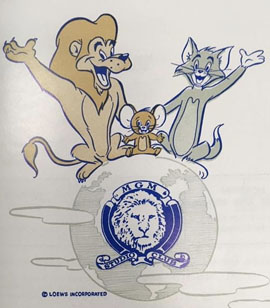
Beck: There was no notice?
Hanna: No. No notice at all. They just said they were discontinuing production. Fortunately, we had started enough cartoons that it was going to take us at least six months to finish those. We had six months to decide what we wanted to do, which was a real blessing.
Beck: What happened next?
Hanna: We immediately began to plan: What could we do? What kind of characters? How were we going to do it? We both knew that it was a pretty bad scene for animators out there, and we’d been successful doing Tom & Jerry. We felt we should do our own thing, start our own company, from the day they said ‘Closed.’ We had a plan in place by the time we got our last MGM paycheck.
Barbera: (sarcastically) It was a great deal…ooh, what a turkey. But there was nothing out there.
Hanna: We financed ourselves with the pension money that we had accumulated at MGM. And we never did have to go in debt or borrow to make Hanna-Barbera work. We were able to use the money that we had, make the first cartoon and get compensated for it in a very short time.
Beck: Where do George Sidney and Screen Gems fit in?
Hanna: Sidney was a friend of ours, we worked with him on Anchors Aweigh and Invitation to the Dance. George and his father, L.K. Sidney, had connections at Screen Gems (Columbia Pictures TV department) and, through them, we had a meeting there.
Barbera: They came back to us with a deal, a terrible deal. There was no money in it. They didn’t have any money. It was like 3,000 bucks for five minutes of a cartoon. We were getting 45,000 to 65,000 thousand for a five-minute Tom & Jerry! We had to use every trick in the book to make it move without spending a lot of money.
Hanna: For peanuts…
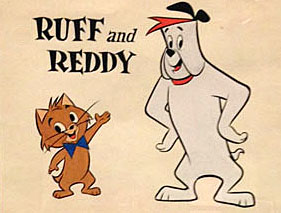
Barbera: Shortly after we began production, we got a call from John Mitchell, head of sales for Screen Gems, and he was promoting all this stuff. He said, ‘Bring over whatcha got. Harry Cohn wants to look at it.’ So we go over to this crummy little projection room, as big as this office…I mean, it was the bottom of the barrel, I’ll tell ya. Television was pushed off into the old part of the building. We sat down with the first pencil test of Ruff n’ Ready and in come Harry Cohn and John Mitchell. The lights go out and you know, if you don’t know what a pencil test is and you’re looking at these pencil lines squiggling around – you really have to be a professional to be able to read it – and they ran it.
Hanna: It didn’t look bad.
Barbera: The point is that it was a pencil test. And Harry Cohn doesn’t look at pencil tests. And it finished, and they got up and walked out. Didn’t say a word. So later I called John Mitchell and asked, ‘What did he say?’ He says, ‘Get rid of them.’ Now…again fate steps in. In New York, a guy named Roger Muir had a children’s show on NBC. And he wanted to use these five-minute cartoons in his show. If it wasn’t for that, we’d be out of business.
Hanna: Luckily he liked them.
Beck: How did you hook up Huckleberry Hound and Kelloggs?
Barbera: John Mitchell set up a meeting with Kellogg’s ad agency, the Leo Burnett people. I went to Chicago with nothing to show them, but we agreed to develop Huck, Pixie & Dixie, and two itinerant bears who later became Yogi and Boo-Boo.
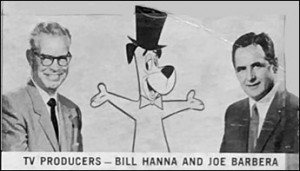 Beck: What was it like going from full-animated pantomime cartoons to limited-animation, dialogue-heavy pictures?
Beck: What was it like going from full-animated pantomime cartoons to limited-animation, dialogue-heavy pictures?
Barbera: Another world.
Hanna: It was another world, but also it was the only way that we could meet the economies of making pictures for television.
Beck: Did your roles as directors change after MGM?
Hanna: No, I think that we went on, each of us doing what we did best – working together on material, I was working on timing and with the animators, Joe working with story people and doing the big selling job.
Babera: We didn’t have time to breathe. It was 17 hours a day. We would be working on stories and timing all day long, then at night time we would go over to a soundstage on Sunset Blvd. and record a picture. This was five nights a week. We did a different cartoon, a Jetsons one night, we’d do a Top Cat another time, a Huckleberry Hound another night. Then we’d go across the street to the Naples restaurant and eat, at about eleven o’clock at night, with all these guys.
Hanna: We worked very hard.
Beck: Where did the idea to do a prime-time series come from?
Hanna: I think we were asked to do that.
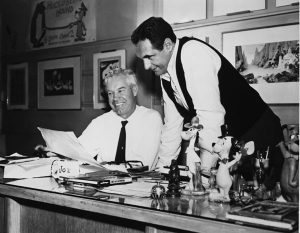
Barbera: John Mitchell. He was relentless about doing it and you know, personally, I felt to myself, he’ll never get this off the ground. I night-time animated show, are they kidding? But he wouldn’t let up.
Beck: As cartoons became big business for TV in the late ‘60s, the traditional approaches to production were changed. For example, television writers replacing cartoonists, scripts replacing storyboards, and so forth.
Hanna: We have, all of our lives, worked with storyboards. So if a script is written, a storyboard is created. There are a lot of writers that are qualified and can write some darn good material, but they can’t draw.
Beck: Aren’t cartoon artists more creative in designing and writing cartoons?
Barbera: Oh yeah. No question.
Hanna: Yeah, that’s right.
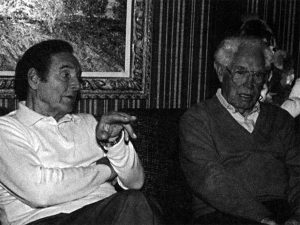
This photo, printed in ANIMATION MAGAZINE along with this interview in 1994, I believe is of Bill and Joe answering my questions. This is how I remember them, sitting on a couch together like this. I guess a studio photographer snapped it. I was too mesmerized by Bill and Joe to recall anyone else in the room. – Jerry
Beck: Was that the beginning of The Flintstones?
Barbera: Yeah, the very beginning.
Beck: So you weren’t hiding the connection between The Flintstones and The Honeymooners?
Barbera: Anytime anybody says to me ‘Hey, isn’t a lot of The Flintstones like The Honeymooners and didn’t you rip it off?’ I say, ‘Hey, look…you wanna compare us to The Honeymooners? That’s the best compliment you could ever give it.’
Beck: Do you guys ever keep in touch with Jack Nicholson?
Barbera: He was the office boy at MGM.
Hanna: He has often talked about us. As a matter of fact he recently quoted me telling him not to quit MGM. He said I told him, ‘Don’t be a fool. You have your chance here to become something. Stay with it.’
Barbera: He used to bring us Cokes, he’d wheel in the cart, go in the offices and ask, ‘What do you want today?’ So years later I’m standing in the Polo Lounge, and I hear this voice in my ear say (Joe doing a wicked Jack Nicholson imitation), ‘Mr. Bar-ber-a?’ – I respond, “I’ll have a coke with two milks!’ (Laughs.) We’ve kept in touch. He’s just a real terrific guy. If he needs a job, he oughtta call us, y’know?



 Jerry Beck is a writer, animation producer, college professor and author of more than 15 books on animation history. He is a former studio exec with Nickelodeon Movies and Disney, and has written for The Hollywood Reporter and Variety. He has curated cartoons for DVD and blu-ray compilations and has lent his expertise to dozens of bonus documentaries and audio commentaries on such. Beck is currently on the faculty of Cal Arts in Valencia, UCLA in Westwood and Woodbury University in Burbank – teaching animation history. More about Jerry Beck [
Jerry Beck is a writer, animation producer, college professor and author of more than 15 books on animation history. He is a former studio exec with Nickelodeon Movies and Disney, and has written for The Hollywood Reporter and Variety. He has curated cartoons for DVD and blu-ray compilations and has lent his expertise to dozens of bonus documentaries and audio commentaries on such. Beck is currently on the faculty of Cal Arts in Valencia, UCLA in Westwood and Woodbury University in Burbank – teaching animation history. More about Jerry Beck [



































A good interview, and you clearly made the most of the opportunity. Those questions about Milt Gross and Jack Nicholson really must have taken Bill and Joe by surprise!
There were two Honeymooners writers who later wrote for The Flintstones, Herbert Finn and Sydney Zelinka, and Joe Barbera must be referring to the latter. Zelinka’s few episodes all ran in the first two seasons, and while they’re not bad episodes per se, they all involve fairly standard sitcom setups. Finn, on the other hand, wrote or co-wrote two dozen episodes of the show and would later contribute a couple of scripts for Jonny Quest, so Joe must have been pleased with his work, whether he could draw or not.
This might be a subject for another column, Jerry, but I’m curious: of all the figures in animation history whom you never had a chance to interview, which ones do you most wish you had, and what would you have asked them?
I wish I could speak to them all, all over again, as I have a million new questions.
Tex Avery was my biggest fish that got away – from me. I never met him – but I have dozens of friends who had – and asked him many questions (on camera and off).
I wish I could have met someone like Seymour Kneitel. I’d still like to hear his perspective on working with Paramount all those years.
This is a great interview.
Ironically, last night, I was watching some episodes in the first season of “the Flintstones“, and I was trying to remember the talent on hand, working with Bill and Joe at the time; were most of them the same as on their MGM staff? I can’t quite remember. At any rate, I was sorry to read that they consider a lot of the in-between cartoons to that point at which Tom and Jerry was created to be inferior. I thought some of them were quite good. I especially liked the Count Screwloose cartoons, and I didn’t realize that Bill and Joe animated on them. Those of us who own the wonderful “Art of Tom and Jerry“ laser disc boxes no of some of these in between cartoons. A lot of the titles on which the duo directed are actually on the final side of the final box.
Jerry, this was another great job! In the space of that 20 minutes, you got some very interesting information.
Quite a lot was covered in that 20 minutes. Imagine if it had been an hour!
Wish you had pressed for details as to why B&J consider the Gross shorts so awful. I think those are two of the funniest cartoons from the pre-WWII era.
I love University Of Mississippi Press’s conversations with comic artists series. The Mort Walker Conversations was key to my undergraduate dissertation. Chuck Jones, Charles Schulz, and Carl Barks are all also great books.
Nice post thanks, Jerry. For a short interview this was surprisingly comprehensive, and very accurate. And I agree that they were obviously aware from the start that you were knowledgeable. They sounded like they wanted to set the record straight about the early beginnings of H-B, and until this sit-down interview they mostly had to endure endless fan-types who just wanted their autographs.
Nice job, Jerry! From the interviews I’ve done with animators, some of these guys really appreciate it when you DO YOUR HOMEWORK and ask them a question or two that they probably haven’t been asked many times before! Or, sometimes even better – ask them to go into detail with follow up questions that are, again, “a little off the beaten path.”
I have both autobiographies of Bill Hanna and Joe Barbera and while they ere good, I wish they had collaborated TOGETHER on making one big book. When I interviewed Dave Tendlar, I wished that I had access to some kind of speaker phone hook-up where I could have him talk awhile with animator Gordon Sheehan. Because, in a lot of animation history, “two heads are ABSOLUTELY better than one.” Thanks for sharing that, and I hope it gets published someday in some animation anthology!
I tried to do that a little with Shamus Culhane regarding his working with Frank Capra. Sadly, the video footage was edited for a cable TV station in the Chicago area and I didn’t get the master tape when I asked ASIFA-Central head Dave Daruska for it, he only had a VHS tape of the edited broadcast, sadly!
For a short interview, this turned out pretty great. And though it didn’t make it into the forthcoming book, it does sound like it could be a really nice collection, and a nice adjunct to their autobiographies. As a child of the 70s, I grew up on H-B, and remain a huge fan.
I have the LD sets, too, and will never part with them. I’m not the biggest Tom and Jerry fan, really, but it’s nice to have the whole series uncut and in order, plus the various bonus cartoons. I watched the LD sets with my son again (plus the Chuck Jones volume) a few years ago, after the Blu-ray releases got cut short. Also nice to own are the Hanna-Barbera Personal Favorites laserdiscs, which also got VHS releases. On those, Hanna and Barbera introduce the cartoons. It’s all pretty hokey and superficial, but still fun to see.
FANTASTIC INTERVIEW! ANSWERED A LOT OF QUESTIONS.
QUICK Draw McGraw YOGI BEAR. I still have the music in my head.
I watched only HB CARTOONS. I just didn’t care for Disney – I’m grown up now – and I still LOVE the Flintstones!
I’ll second it, you did a great job with the limited time!
Such an excellent interview, Jerry! For 20 minutes, William Hanna and Joseph Barbera offered a solid glimpse into what made Hanna Barbera so successful. Upon reading Joe’s autobiography, My Life in Toons, I recall him stating that Bill was more on the mathematical and economical side of the business whereas Joe was the salesman and the artist side of it and it certainly shows how much their opposites complemented and elevated their efforts.